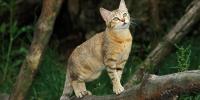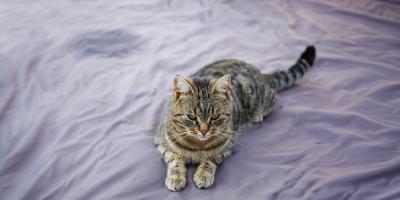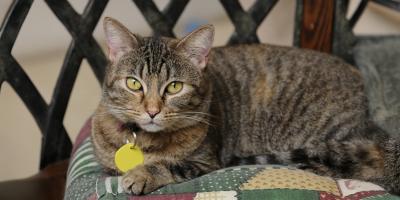Domestic Cats vs. African Wildcats: What Do They Have in Common?


When comparing the wildcat vs. domestic cat, there may not seem to be obvious similarities.
For most people, the term "wildcat" conjures up images of mountain lions or cheetahs, but are these animals really so different from the domestic tabby cat?
Get to know felis silvestris lybica, commonly known as the African Wildcat, and you'll see the likenesses are remarkable.
To understand these similarities, it first helps to have a brief overview of the origins of cats. (Curious about different kinds of domestic breeds? Check out our Cat Breeds page.)
The History of Cats – a Brief Overview
While DNA research has identified five wildcat species as the closest group of ancestors to domestic cats, cat ancestry shows the African Wildcat is the wild ancestor that was first domesticated in the Middle East’s Fertile Crescent region 9,000 years ago.
If you’re wondering, “How did cats become domesticated?”, you may be interested to know domesticated cats in ancient Egypt were originally kept as a means of rodent control, and used to hunt fish and birds. Later, they were exported to Asia and Europe and arrived in North America in the seventeenth century.
Cats have held symbolic significance across different religions, and fallen in and out of favor with society over time.*
Selective breeding of cats is a relatively new practice. Around 150 years ago, people began pairing felines to achieve various looks or temperaments.
Wildcat vs. Domestic Cat – The Similarities
So if our feline companions share a lineage with the African Wildcat, what else do they have in common? Here are some of their similarities.
Coat & Markings
The African Wildcat is sandy brown to yellow grey in color, with black stripes on the tail, orange-colored ears and underbelly, white rings around the eyes, and black rings around the tail and bottom of the legs.
These dark markings help them blend into their surroundings in both deserts and savannahs in order to conceal themselves from predators and prey. Their coloration can be lighter or darker, depending on their home environment.
The domestic cat breeds with the closest comparison in both color and pattern are the Abyssinian and Mackerel Tabby.
Stature & Body Weight
The African Wildcat ranges in head-body length from 18 to 30 inches and typically weighs 6 to 14 pounds.
Both measurements are slightly larger than the average domestic cat and are comparable with the larger breeds of shorthair domestic cats like Abyssinians and Bengals.
Most likely attributed to their activity level in the wild, African Wildcats are noticeably lean and muscular and almost always in ideal body condition.
Legs
African Wildcats have legs that are long in proportion to the rest of their body. Those long legs are an advantage while running, leaping, pouncing and seeking refuge up in trees.
While most domestic cats have shorter legs, they do exhibit similar behaviors like chasing after bugs, pouncing on a toy, or climbing up to a perch on a tall piece of furniture.
This is why it's important to work with your cat to help improve their agility (possibly through games) as it also helps stimulate their mind, body and natural instincts.
Paws
Retractable claws stay tucked under the skin of the paws when the Wildcat is on the move, but get extended to help with climbing, hunting or fending off predators.
They'll scratch on trees to keep their claws fit. Domestic cats instinctively seek out similar situations, which is why it's important to provide them with a sturdy scratching post and a horizontal scratching surface as an alternative to furniture, rugs or curtains.
Eyes
The African Wildcats' retinas contain a layer of cells that reflect light back into the eye, making them ideally suited for hunting at night.
Pupils constrict down to thin slits in broad daylight, and dilate very wide at night. This helps them make the most of available light. Dilated pupils can also be a sign of excitement.
The domestic cat is equipped with equally amazing eyes that allow them to play and roam around the house, even when the lights are off.
Whiskers
Fanned or flattened, pointed out or down—domestic cats are quite similar to African Wildcats in the way they vary the position of their whiskers to communicate.
Since the whiskers extend the width of the head, they're also used to measure openings to ensure there's enough space for the cat to fit through.
Whether it's your cat exploring your home or a wildcat out hunting, this is especially handy while navigating their surroundings when they're on the prowl at night.
Teeth & Side Chewing
African Wildcats are carnivorous and typically hunt for rodents, birds, reptiles, frogs and insects.
They're able to open their mouths extraordinarily wide. Canine teeth are used for piercing, tearing and grasping, while modified molars work like scissors to sheer meat into pieces small enough to swallow.
When using their molars, both wildcats and domestic cats use a technique called side chewing. It's easy to spot; the cat will turn their head as they shear the food with the best teeth for the job.
Ears
Orange in color and distinctively shaped, African Wildcats have what are referred to as rufus ears. They're highly sensitive, and they're able to rotate to sense the directionality of movements of both predators and prey.
While your cat's shape and coloring may differ, they’ll use their ears to communicate just like their ancestor.
Ears pointed straight up can indicate a relaxed state. Pointed forward means they’re feeling friendly or attentive. They’ll signal fear with ears that are flattened and pointed out slightly to the side.
Tail
When comparing a wildcat vs. domestic cat, note the African Wildcat's tail is longer than that of your feline companion.
This helps with balance while climbing and chasing prey. Like their wild relative, however, the positioning and movement of your cat's tail can be used to communicate a mood, much like their eyes, ears and whiskers.
Remember, if you have questions about your cat’s behavior, you can always ask your veterinarian. For more insight into your cat, visit our Pet Expertise page for guidance from our experts.
*Beaver, B. V. (2003). History of Feline Development. In Feline Behavior: A Guide for Veterinarians (2nd edition, pp. 1-4). Saunders.
Related articles

Earn myPurina Rewards with Every Purchase
Use your points for treats, toys, and gift cards with myPurina app.






